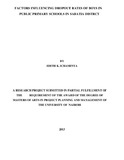| dc.description.abstract | Education like any other forms of investment in human capital can contribute to economic development and social
progress. The Kenya government has placed certain measures to give basic education to its citizen for instance the
introduction of Free Primary Education – FPE. The underlying causes of dropout remains obscured and that is why
this study sought to investigate the factors that influence dropout of boys in public primary schools. The objectives
of the study are to investigate the causes of school dropouts among pupils, to investigate the rate of drop out
amongst boys and to investigate measures that can be put in place to control the boy’s dropout. The justification for
investment is that education is not a basic right, just also a basic component of social and economic development.
The literature review identifies the challenges such as a family socio – economic status; environmental factors
school related factors and HIV/AIDS pandemic as factors influencing dropout rates of boys in public primary
school. The boys who dropped out of schools came back to school were established through the school records such
as class registers and admission books. The research design is descriptive survey; the target population was 30
people. Sampling techniques and sample size 10 of head teachers, 10 class teachers and 10 parents/guardian.
Purposive sampling used to select school dropouts who not presenting in school to respondents, purposive sampling
is one that is deliberate and nor random fashion to achieve a certain goal. The main instrument for data collection
were questionnaire, interview schedule and school records. Data collected was analyzed qualitatively and
quantitatively through descriptive statistics validity Data from schools was analyzed using descriptive statistics such
as percentages and then presented in the form of frequency distribution tables and graphs. The researcher observed
especially from the information given on questionnaires to a third party. The respondent names were not written on
the questionnaires. The researcher should be personal identification before respondents and his or her mission.
Validity of the instruments was checked by consultation from my supervisor from the school of continuing and
distance education. Reliability will be measured by test-retest technique. Operational definition of variables was
used to guide in data analysis. The family background that had an immense influence on boys drop out were parents
socio-economic stats which include; family income, occupation, literacy level, family size and poverty. The study
established that school related factors that causing dropout of boys were poor academic performance, teachers
attitude, too much work in school and failure to pay school extra levies. Repeating of classes also discouraged pupils
and had to drop out of school. Activities within the surrounding of the school and home were found to attract boys
into cheap labor jobs. Most of the findings indicated that they chose to be out of school to create income in order to
subsidize their parents low income. The study recommends that the school head teachers should not be forcing
children to repeat classes unless they so wish. Repeated examinations should be counseled to improve their
performance. In this study the government was called upon to give a guideline on the extra levies charged in schools
in order to curb the dropout of boys from schools. The community should be sensitized through the ministry of
education on the importance of education. The study also recommends that the government to come with a law on
age that should be allowed to ride bicycles and motor cycles as a business mean. As a basis for further research, the
study should be conducted in the whole country to have an overview of the nation and apply the present findings. | en |

